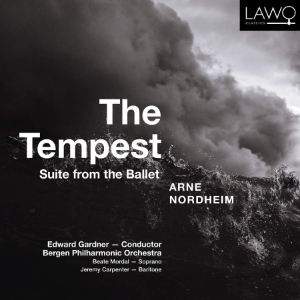
Arne Nordheim (1931-2010)
The Tempest – suite from the ballet (1979)
Beate Mordal (soprano); Jeremy Carpenter (baritone); Bohdan Mazurek (electronic elements)
Bergen Philharmonic Orchestra/Edward Gardner
rec. 2021, Bergen, Norway
Lawo Classics LWC1250 [50]
Nordheim often quested far and wide for musical impact to match or enhance his inspirations. The accordion features in several of his works (Simax) and electonics figure in his scores from as early as his Epitaffio per orchestra e nastro magnetico (1963) (Simax again).
The present substantial suite unequivocally envisions Nordheim’s imagination and gives it a voice. The Tempest spoke directly and pleasurably to the composer’s creative impulse. The play’s liberating and welcoming plot, poetry and dramatis personae here resulted in a most fluent fifty-minute suite of eight movements. The complete work hails from the end of the 1970s.
The Magic Circle movement makes capital use of the solo cello. Unexpectedly the two vocalising voices echo those deployed by the Swedish Alfvén in his quasi-Straussian Symphony No. 4. In that sense it also links with the highly intoxicating super-exuberance of Nicholas Maw’s Scenes and Arias for three female voices and orchestra. As for the solo cello, it returns in the Lacrymae and Caliban’s Warning movements. In A Mazed Trod (6) percussion and bells are to the fore. The Caliban movement (Four Legs and two voices) indulges in dramatic statement, staccato torment, and ultimately in intoxication.
The two voices have a grand part to play all the way through to the final and lengthy Caliban’s warning movement. Here the luxuriant writing is rather like a late Tippett score such as the Fourth Symphony, complete with its theatrical breathing tape. That last indulgent movement has a surfeit of magical sounds. The full choir is heard in a Lark Ascending moment on the rise to spiritual ecstasy. It’s melded with ecstasy in the sense achieved by Herbert Howells in his choral writing. The movement, and the work, ends on a sustained and tense note of transcendent healing.
The work leaves you with a feeling that you have heard the aural echo of “the splendid silent sun”, as Whitman might have put it. This asserts itself unequivocally only in the last movement.
The notes, by Andrew Mellor, are in English. The music is most finely performed under the baton of Gardner who here takes an unaccustomed step out with Lawo. It’s also prominently recorded. The listener is treated to a completely plausible perspective not lacking in telling impact, whether quiet or loud.
Rob Barnett
Help us financially by purchasing from





















